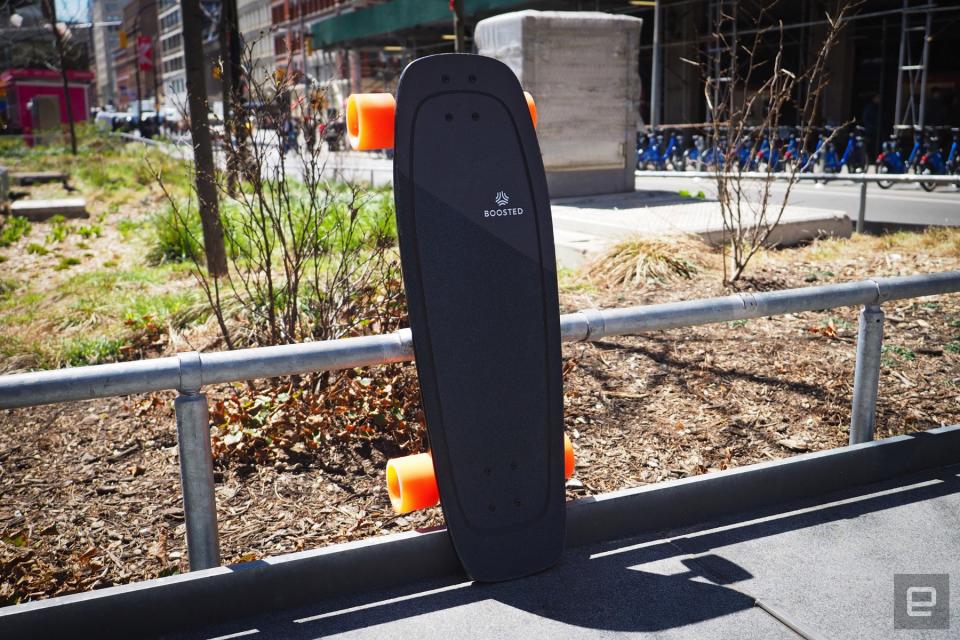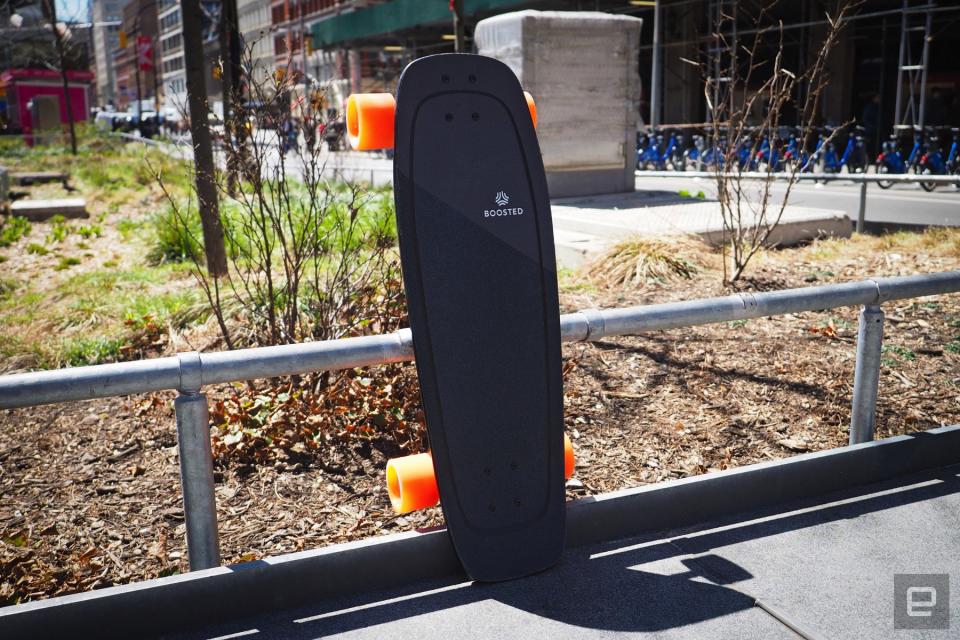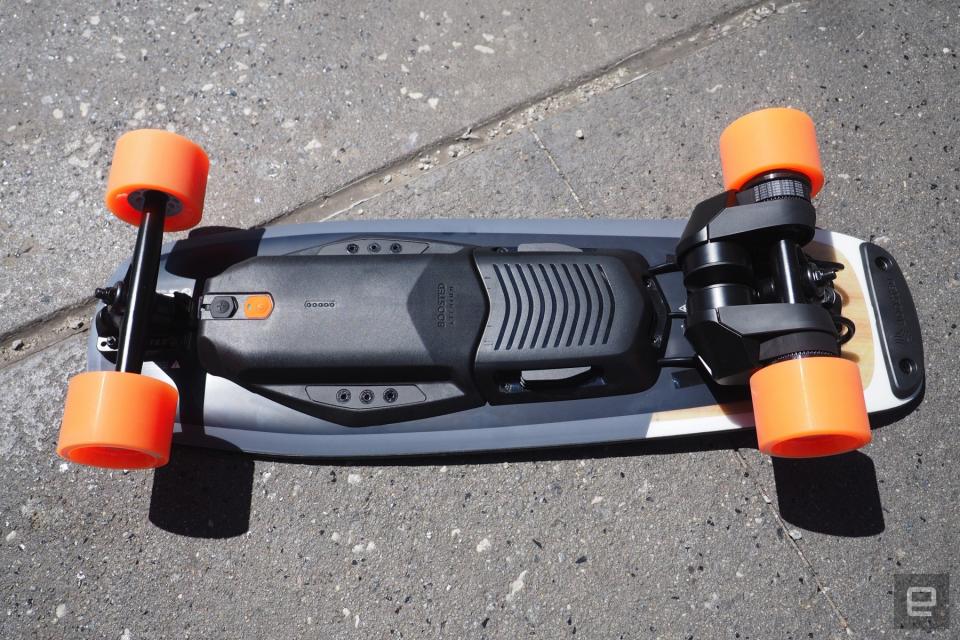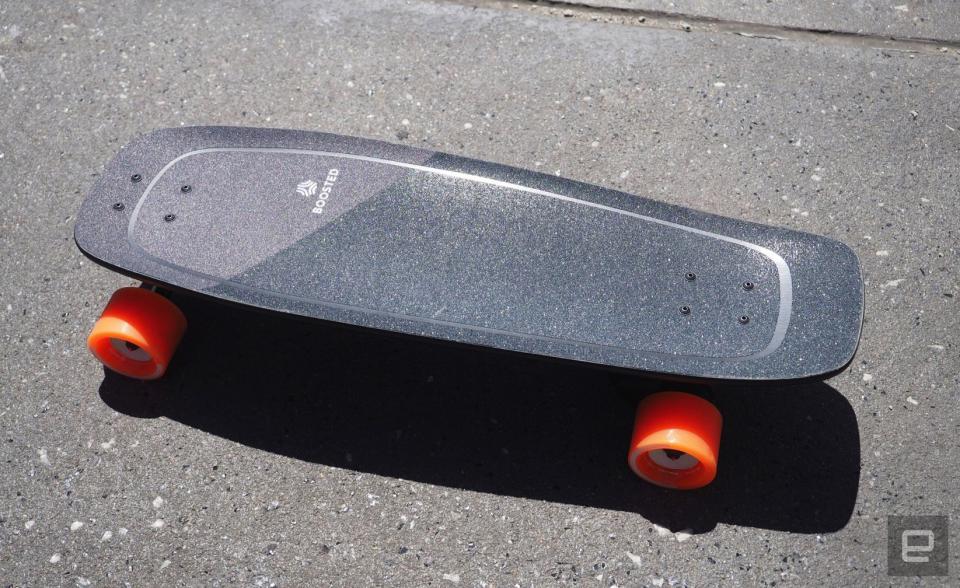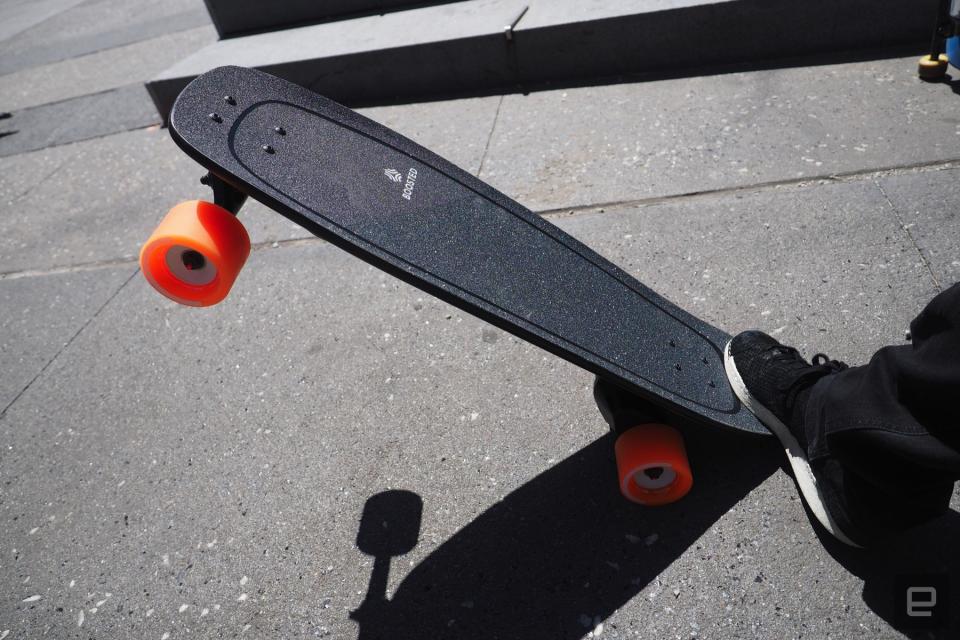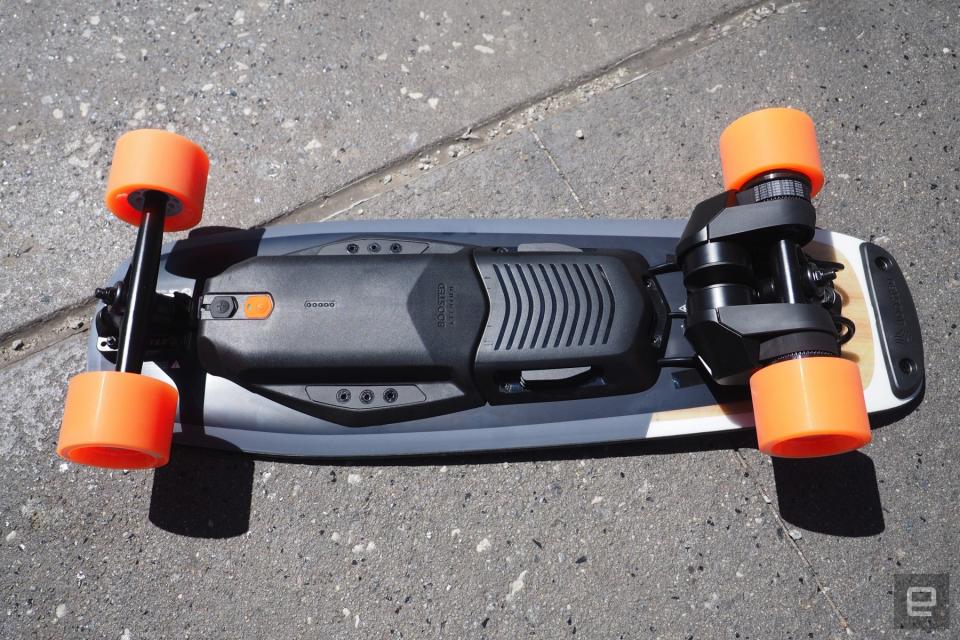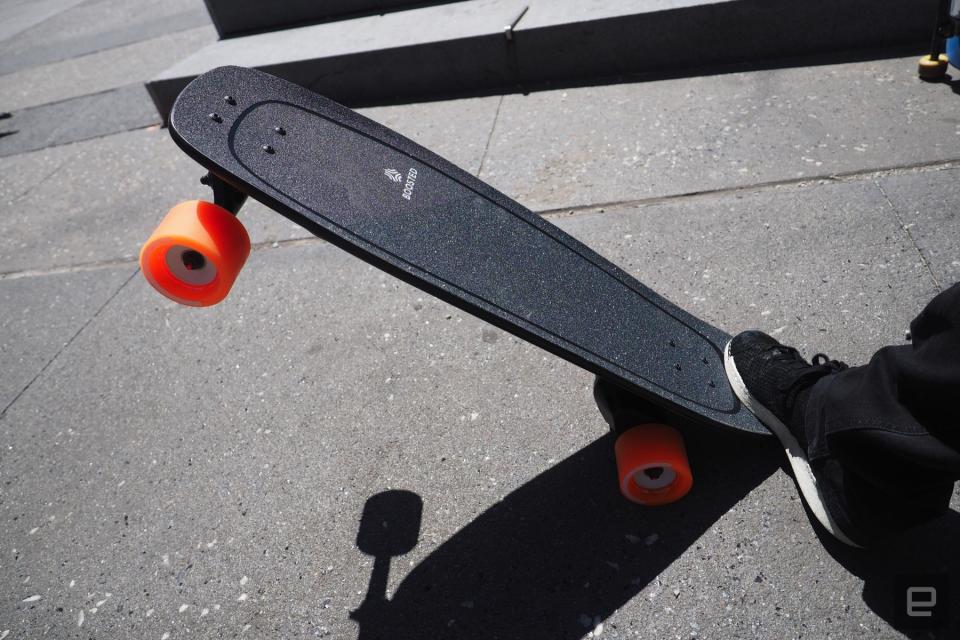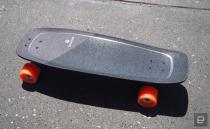Engadget has been testing and reviewing consumer tech since 2004. Our stories may include affiliate links; if you buy something through a link, we may earn a commission. Read more about how we evaluate products.
The case for Boosted's Mini electric skateboard line
I like the speed and maneuverability, but traditional skateboarders won't find much crossover.
Electric skateboards are riding a surge in popularity this past year, with Boosted being one of the more notable players. It's also one of the more recognizable, with its iconic orange wheels. Until now the company's output has strictly been longboards, which is par for the course barring a few exceptions, but the floodgates of mutation are opening. The company's recently released 2018 lineup includes two Mini versions, which is a form factor I've been on the fence about for a while.
There are the obvious benefits, including improved maneuverability and portability (they weigh a couple pounds less than longboards). On my part, at least, there's a desire to try and apply street-skating tactics to these smaller boards, but they're new and unique creatures. Is this hybrid format the best of both worlds? No. These are still transport boards, but given some time, I'm sure someone will get a bit crazy with them.
Let just dispel some of the skateboard-related crossover possibilities right out of the gate. The weight difference between a regular skateboard and the Boosted Mini is drastic. Yes, it's easier to hold the Mini because it's shorter than the 17-pound longboard model, but the S is also only 2 pounds lighter (whereas the X is nearly the same at 16.8 pounds). A regular skateboard seems almost weightless in comparison.
Ollies are gonna be tough. At 15-plus pounds with a short tail and a higher profile, the pop will be late, and trying to push through the weight is gonna be a sneaker-tearing effort. Gravity is in full effect here. Even going up curbs by lifting the nose first isn't ideal, again because of the weight, but mostly since there's not much nose for unweighting the backend in time. That encased motor assembly is gonna get whacked plenty unless you craft a custom Bird Lapper truck guard. You may also be pummeling the battery casing that spans most of the wheelbase on taller curbs, but I've seen some of Boosted's testing methods in that regard, and there's little reason to worry about durability.
With all that said, I'm at least confident in its ability to do powered manuals, so there's hope for more than just cruising with the wheels down.
Creating an electrically powered skateboard in the classic sense, though, isn't what Boosted is about. It's pivoting to the role of transportation company, so facilitating tricks isn't really a priority right now. Plus, with the Android or iOS app, you can track battery level, predicted range and ride history making it a higher category of transport than you'd think a skateboard would be.
The new build

I don't own or regularly ride one of the Boosted longboards myself, but I've spent some time with them over the past few years. The experience with this Mini version isn't the same, but when you're moving forward with your eyes to the horizon, those differences mostly fall to the wayside. The motors on the Mini, though less powerful than the pricier models, are generally the same product as before. The torque for starting and stopping is amazing and comfortable, easily ramping up to speed or slowing down smoothly. If you're in the highest ride mode, you'll still need to lean in and be cautious of over throttling and landing on your ass.
Boosted is proud of its new role as component designer and supplier. It's changed some of the motor's parts to increase strength and longevity. This is something you won't notice in most cases, but it's good to know that they're paying close attention to quality. This shouldn't be news to you if you've ridden Boosted boards or followed the company as it's grown over the past few years.
The trucks are also a Boosted product now and we're told those have been redesigned for durability as well. Again, not much to notice at first glance, but it may play a role in the long run. Since the Mini is a smaller model and easier to carry by the front trucks as you're walking around, I noticed that the kingpin sticks out a bit more than regular skateboards, which can make holding it uncomfortable at times.
As for the deck, the company has taken some cues from snowboard manufacturing, with its composite construction. There's a lightweight poplar core wrapped in fiberglass, with a plastic runner along the edges for added protection. Since Boosted hasn't had a shorter model before, there's no way to compare with previous versions. However, you won't get the same bounce the longboards offer. There's no real flex on this size, which is the way it should be, but because the weight of the overall package is fairly heavy, it's hard to say if the deck offers any weight savings in itself.
Price, speed and range

What you have here is a more affordable and maneuverable option, albeit with a bit less power than the longboard models. The Minis run dual, brushless, belt-drive motors totaling 1,000 watts, while the Plus and Stealth are 2,100 watts. The boards are all controlled by a hand-held Bluetooth remote, which is one of the more ergonomic and comfortable units I've used. Very little has changed there.
The Mini S costs $749 and is the most approachable of the bunch, but you're still getting only 7 miles to a charge. That's fine, but you'll need to stay on top of recharging and may want to bring that brick with you most of the time -- or buy an extra to bookend your commute needs. And while the Mini S caps out at 18 miles per hour, its speed threshold will likely be less of an issue for most riders than battery longevity.
If you can afford the upgrade, but like the smaller form factor, you could opt for the Mini X, which we haven't yet tested. The battery is beefier and the total package weighs in at 16.8 pounds (a negligible difference since both are kinda heavy). Still, you get 14 miles range and a top speed of 20 MPH, which sounds like a great pairing. The premium Mini X will cost you $999, but the offset is that you'll have more range on a charge and that means less dependence on that charging brick. As for the bit of extra weight, those ollies weren't really going to happen anyway.
Keep in mind, if you're running any of the boards at full throttle for extended periods of time, you're going to fall short of the maximum rated distance. On the earlier Dual+ longboard rated for 7 miles, I only managed to eke out between 5.2 and 5.8 miles before the battery died. And while the motors have amazing torque for starting and stopping, that also makes pushing the board without juice more difficult than you'd expect.
To manage your speed threshold you can use either of the three ride modes, which offer a good spread for various moods and skill levels. The first is slow enough to help avoid most incidents of overthrottling but won't get you anywhere very quickly. It's barely a brisk walking pace, which is a perfect safety mode for beginners. The second is akin to a run and will get you down the street well enough, but if you're used to the board, you'll still be clamoring for more. Mode 3 moves you at a decent clip and you'll want to lean in if you throttle up quickly. If you're familiar with the more powerful longboards, though, you may miss that extra bit of speed.
Boosted Mini S ($749) | Boosted Mini X ($999) | |
Range | Up to 7 miles | Up to 14 miles |
Top speed | Up to 18 MPH | Up to 20 MPH |
Hill climbing | Up to 20% grade | Up to 20% grade |
Modes | Three ride modes | Three ride modes |
Wheels | Boosted Lunar 80mm | Boosted Lunar 80mm |
Weight | 15 pounds | 16.8 pounds |

The ride
As much as I try to compare the ride of the Mini with standard skateboards, it's just not going to work. The biggest bridges between the two are the smaller deck length, concave surface and kicktail. One thing I would have liked to see is a bit more nose on the deck. This means if you like the classic skateboard running start where you drag the tail while holding the board's nose, it's pretty awkward.
I'm only 5-foot-7, which I'd guess is an average height, but there's not a ton of space on the board for me. You can ride with your front foot up over the front trucks to spread out a bit, however that feels weird being so far over the front. If you keep your front foot back a touch, you invariably may end up with your rear foot on the tail to employ a comfortably wide stance. This may be subjective since the board isn't that much shorter than a regular deck, but perhaps at higher speeds, a wider stance feels preferable. Smaller people may find the sizing perfect, however, and that's one of the recommendations I have for this model. It's probably ideal for younger or smaller riders.
As I mentioned earlier, tricks are pretty much out of the picture, and stepping it up curbs isn't ideal. The smaller size and wheelbase, however, does allow for far more maneuvering than a longboard can offer. You can use the tail to kick and tic-tac your way around turns or obstacles, which is pretty special when riding in urban environments. That said, the trucks are very wide compared to normal skateboards, placing the wheels more than an inch beyond the deck's side. This is great for stability at speed (phew) but not so hot for really smooth and tight kick-turn action.
During lulls in my commute with the deck at my side -- you know, bodegas, elevators, subways -- it's just tall enough for me to reach the truck. Taller people may have to either carry it or hunch over to rest the tail on the ground. Conversely, smaller folks will be glad having something less gargantuan to deal with. As for the riding the subway with a phone in one hand, it was a bit low to entwine my fingers around both the pole and trucks for comfortable support, given its height. Luckily -- and just barely -- I was able to stand over the whole thing, although mind that kingpin in those situations!
The competition
Ignoring the longboard variants on the market, I can focus on a couple of smaller-sized electrics that I've tried. The Elwing is a near-standard-size skateboard deck with a single hub motor and slimmer truck-width than the Boosted Mini. Although this was a beta when I tried it, I've found hub motors overall to be less than impressive for smooth starts and stops. It still has a high profile and big wheels, but with a longer tail and more nose, the ride more resembles a regular skateboard experience than most. It costs €799, but the company is based in France, so domestic US availability is slim.
Riptide's offering was the closest thing to the Mini S and passed through its crowdfunding prior to Boosted's new release. It had a similarly sized deck to the Mini, but where that has rounded or blunt edges, the Riptide R1 Elite offered surf-style sharpness and carrying handles, along with an eight-mile range and 20-MPH threshold. It also employs a belt-drive system like the Boosted boards. You'll save a few dollars as opposed to the Mini, with its top-tier price at $729 including a set of lights, but it's a new company fresh out of the gate.
Wrap-up

The biggest question here isn't about the quality of Boosted's Mini, since the company has proved itself in that regard and its move into parts only adds to its ability to oversee that on a component level. If it's a choice between a pricier longboard model or the Mini series, this comes down to terrain and style preference. The Mini is more adept in tight places, where the longboards are better at long distance cruises in open space. It's also about bulk, choosing if a slightly lighter Mini model will work better than a massive longboard for when you're not riding it. The other question is about you. If you're smaller, you may benefit more from the Mini series of Boosted boards. Price is also a factor and the Mini S (and even the X) put a high-quality electric ride closer to reality in terms of affordability.
As for me, I'm still on the fence. Don't get me wrong, I like what both the Mini offerings and the upcoming Plus and Stealth versions entail. I'd highly recommend them for people looking for an electric ride that'll get them from A to B in the open air and in an eco-style. But while these Mini models are less expensive than many others, it's still a big expenditure. If money weren't an option, though, I think I'd lean toward a Mini for my NYC environs and particular use case. However, given a long and smooth straightaway, the longboard would be my preferred method of shrinking distances.
